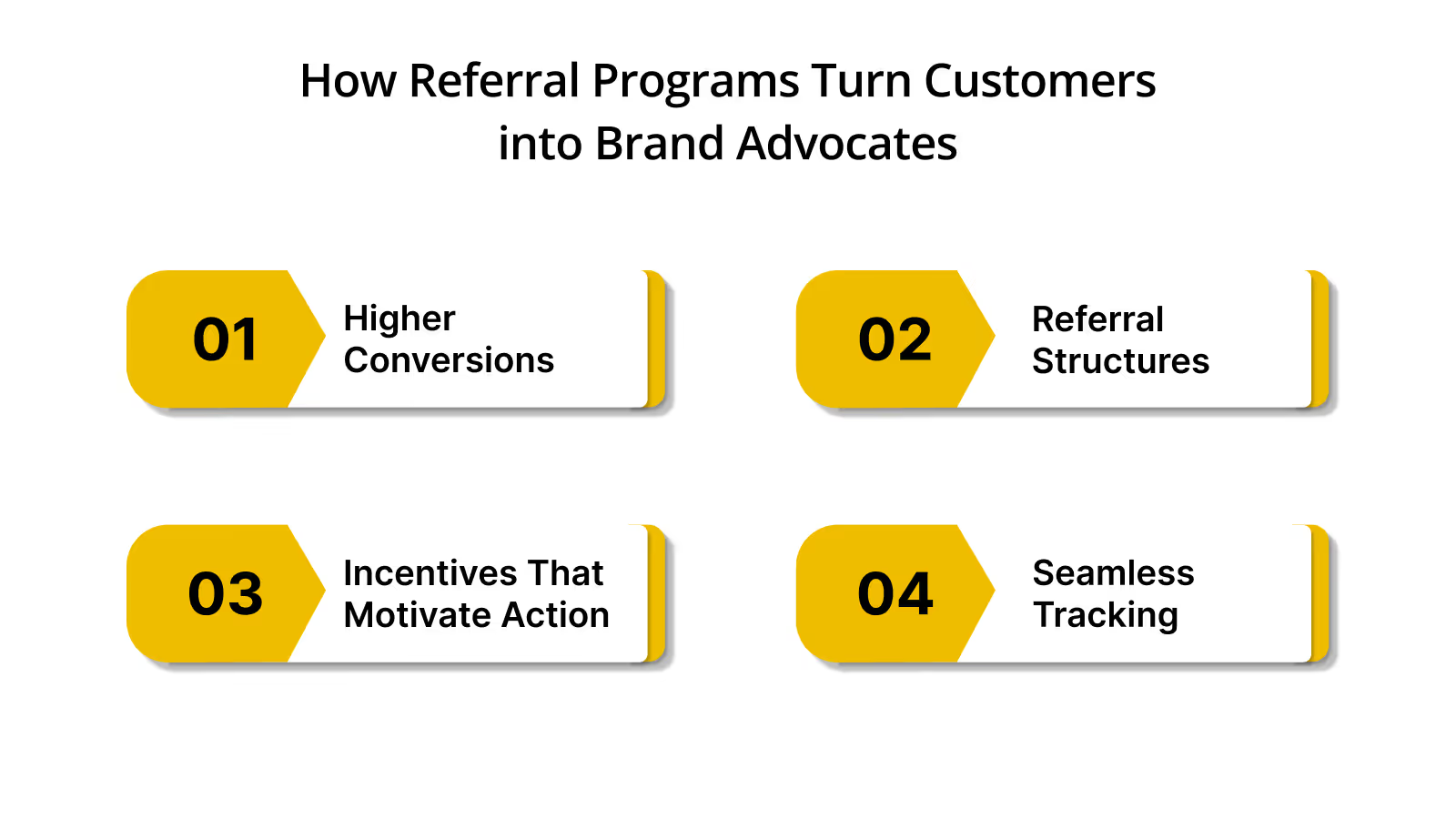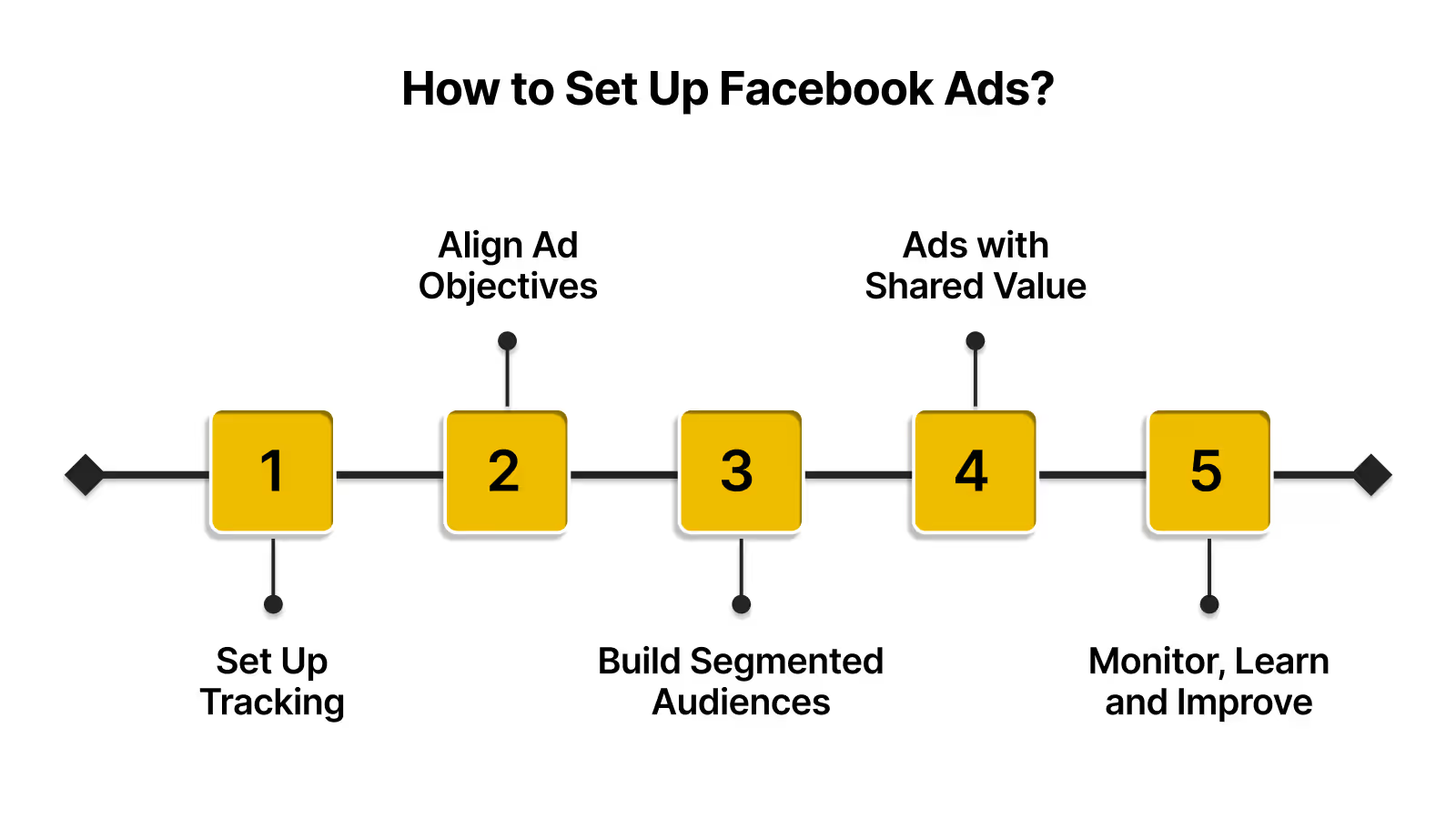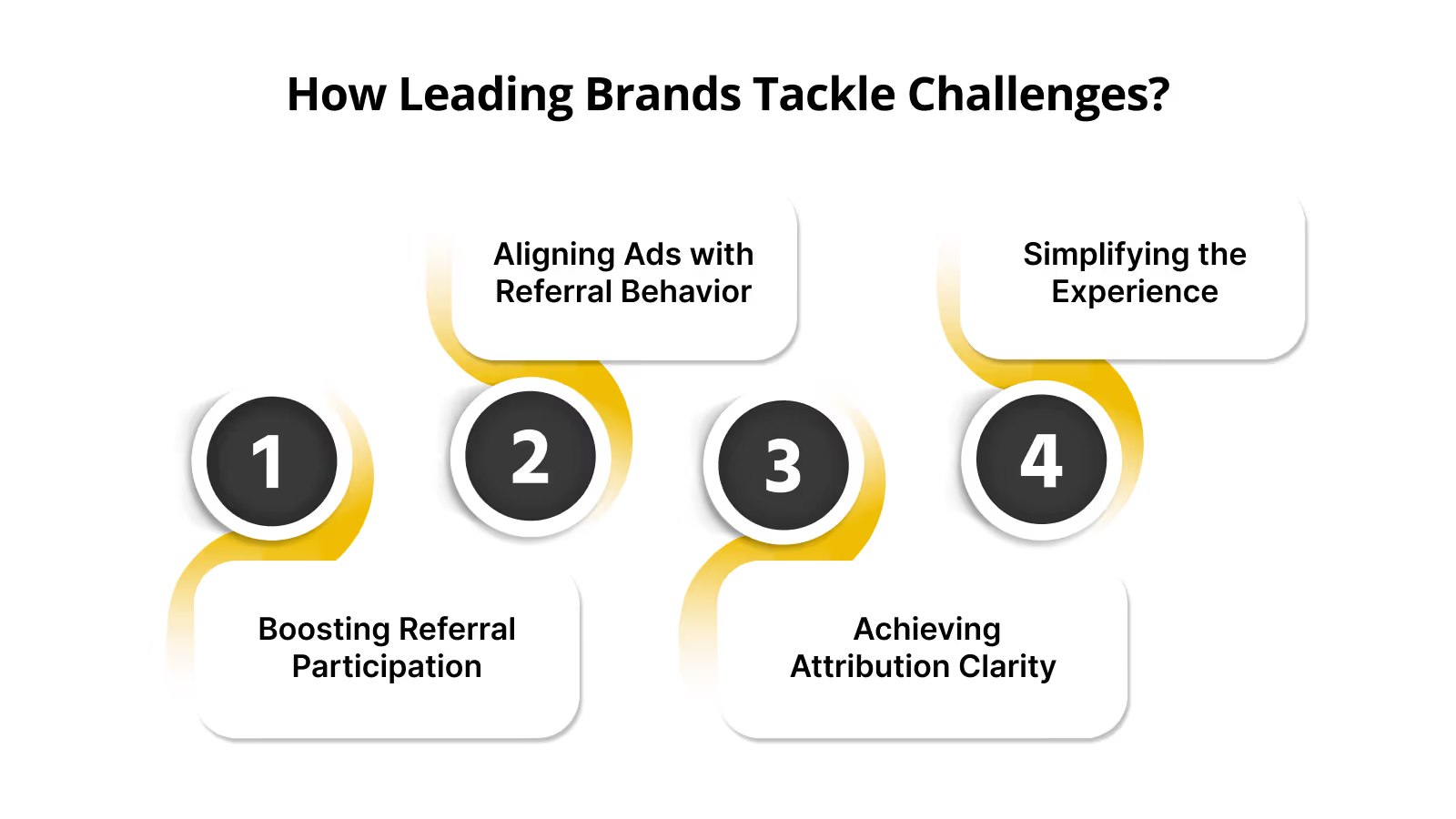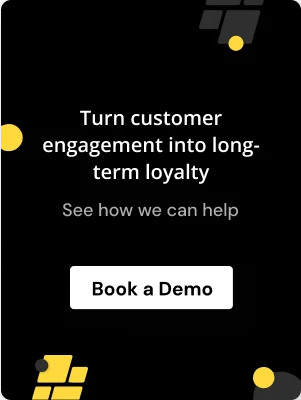.avif)
.avif)
Most e-commerce stores spend heavily on acquiring new customers, yet as many as 60% never return, as per the Shopify Future of Commerce Report, 2024. For founder-led Shopify stores or small teams, this creates a constant struggle to balance ad spend with meaningful growth.
Facebook Ads can connect you with shoppers who are already interested in products like yours. At the same time, referral programs help turn those first-time buyers into a reliable source of new customers at a far lower cost. Together, they create a growth system that combines quick customer acquisition with long-term retention. This blog will show you how these two strategies work, why they’re more powerful when used together, and how to implement them on Shopify to build a sustainable, cost-effective acquisition engine.
How Facebook Ads Help You Attract High-Intent Shoppers
Reaching the right audience is one of the biggest hurdles for e-commerce stores. Posting on social media or running broad ads often means spending heavily without seeing enough sales.
Facebook Ads give you access to a massive audience and the tools to target people who are most likely to buy. With detailed filters based on demographics, interests, behaviors, and past interactions, you’re not just buying clicks, you’re connecting with shoppers who are genuinely interested in your products. Here’s how Facebook Ads help you bring in customers who are ready to purchase:
- Precise Targeting and Retargeting
You can target potential customers based on interests, browsing behavior, and purchase intent. For example, if you sell fitness apparel, you can reach people who follow specific fitness influencers or who have shown interest in health-related content. Retargeting takes it further by reconnecting with users who visited your store but didn’t make a purchase, reminding them of the products they viewed.
- Clear Ad Objectives and Formats for Every Stage
Facebook offers multiple ad formats - carousel ads, video ads, and dynamic product ads, each serving different goals. Prospecting ads help you introduce your brand to new audiences, while conversion-focused campaigns push high-intent shoppers toward checkout. This structure lets you guide buyers from awareness to purchase without wasting ad spend.
- Dynamic Product Ads Synced with Shopify
By syncing your Shopify product catalog with Facebook, you can run dynamic ads that automatically display products a shopper viewed or added to their cart. This personalized approach significantly increases the likelihood of a return visit and purchase.
- Conversion Tracking with Meta Pixel
Installing the Meta Pixel on your Shopify store lets you track key actions like page visits, product views, and purchases so you can see exactly which ads are driving revenue. This data also powers custom audiences and lookalike audiences, helping you find new customers who resemble your best buyers.
When used strategically, Facebook Ads do more than just generate traffic. They help you attract the right kind of shoppers, those who are interested, engaged, and far more likely to convert.

How Referral Programs Turn Customers into Brand Advocates

For most small Shopify stores, acquiring customers is one of the biggest expenses. Ad costs add up quickly, and when those buyers don’t return, it can feel like pouring money into a leaky bucket. Referral programs provide a smarter alternative by using your existing customers’ trust and influence to bring in new buyers at a much lower cost than traditional advertising.
Why does this work so well? People trust people. According to Business News Daily, 92% of shoppers trust recommendations from friends and family more than any ad. A thoughtfully structured referral program taps into this behavior by rewarding customers for sharing your products with people who are far more likely to convert. Here’s what makes referral programs effective:
1. Lower Costs and Higher Conversion Rates
Referrals operate on a performance-based model; you only provide rewards when a referred customer makes a purchase. This makes acquisition costs predictable and ensures that every dollar spent goes toward actual conversions. Referred customers also tend to buy at much higher rates compared to those acquired through ads.
2. Referral Structures That Drive Results
The design of your program matters. Effective models include:
- Single-sided programs - Reward only the referrer with a discount or store credit. These are simple to manage and work well for early-stage stores.
- Two-sided programs - Reward both the referrer and the new customer (e.g., “Give $10, Get $10”), encouraging broader participation.
- Tiered programs - Offer escalating rewards based on the number of referrals. This gamified approach keeps customers engaged and referring over time.
3. Incentives That Motivate Action
Rewards should feel valuable. Discounts, store credits, or perks like early access to new products work best because customers see immediate benefits. The right incentive depends on your margins and what resonates with your audience.
4. Seamless Tracking and Automation
For a referral program to be effective, it needs clear tracking, accurate verification, and timely reward distribution. Platforms like Nector offer built-in automation for these tasks, helping teams reduce manual oversight and maintain consistency. This kind of setup is particularly useful for growing Shopify stores that want to focus on strategy rather than day-to-day program management.
Many successful Shopify stores combine these tactics. For example, fashion brands often use two-sided programs that give discounts to both referrers and new customers, while adding tiered rewards to keep advocates engaged over time. When done right, referral programs do more than generate sales.
Why Facebook Ads and Referral Programs Work Better Together
Running ads and referral programs independently can deliver results, but combining them creates a growth system that compounds over time. Ads bring in shoppers who may not have discovered your store otherwise, while referrals transform those customers into advocates who organically drive more traffic. Let’s have a look at how each layer builds on the other:
1. Ads Drive Referral Program Participation
Facebook Ads aren’t just for pushing products; they’re an effective way to grow your referral program. Instead of relying solely on organic sign-ups, you can:
- Retarget past buyers with referral-focused ads (e.g., “Invite a friend and earn rewards”), ensuring your best customers know about the program.
- Use dynamic ad formats to showcase personalized rewards or highlight referral benefits based on previous purchase behavior.
- Test multiple creatives to find which referral hooks resonate (e.g., “Get $10 off for every friend you bring”).
2. Referrals Improve Ad Targeting and ROI
Referral programs generate valuable first-party data about your most engaged customers, what they buy, how often they shop, and how they interact with your brand. This data can be fed back into Facebook Ads to:
- Build high-quality lookalike audiences based on top referrers, which often outperform cold prospecting audiences.
- Create segmented custom audiences (e.g., frequent referrers vs. one-time buyers) for more personalized campaigns.
3. Lower Acquisition Costs with Blended Growth
Referrals typically bring in high-converting traffic at little to no incremental cost, reducing dependence on expensive prospecting ads. This creates a blended acquisition model:
- Ads acquire new customers.
- Referrals bring additional customers at a fraction of the cost.
- Together, they stabilize CAC while increasing the overall quality of acquired customers.
This approach is especially valuable for small teams managing growth on tight budgets, helping them scale without ballooning ad spend.
4. A Practical Framework: Acquire → Activate → Amplify
To maximize the impact of these channels, think of them as a cycle:
- Acquire: Use Facebook Ads to bring in new buyers. Combine product-focused ads with campaigns designed specifically to promote your referral program.
- Activate: Incentivize new customers to join your referral program with meaningful rewards (e.g., store credits, exclusive discounts, or early access to products). Ensure the process is frictionless.
- Amplify: Feed referral data back into Facebook Ads. Use it to build lookalike audiences, refine targeting, and re-engage customers who haven’t referred yet.
Shopify-based businesses that combine these strategies often report double-digit growth in referral sign-ups and higher lifetime value for referred customers compared to those acquired through ads alone.
When thoughtfully integrated, Facebook Ads and referral programs don’t just operate side by side; they form a self-sustaining growth loop where ads bring in potential advocates, referrals boost acquisition efficiency, and referral data continuously improves ad performance.
Read: Essential Referral Strategies for Business Growth
How to Set Up Facebook Ads That Promote Your Referral Program
Getting customers to join and actively use your referral program takes more than just launching it. When used strategically, Facebook Ads can play a critical role in driving both sign-ups and meaningful participation.
Instead of running them as standalone campaigns, treat them as a part of your broader customer acquisition engine, one that reduces your long-term costs while building a steady stream of engaged referrers and loyal customers. Here’s how to set up Facebook Ads that drive referral momentum.

Step 1: Set Up Tracking Before You Spend a Single Dollar
- Before launching any referral-focused ad campaign, make sure your tracking systems are fully set up and functional. The Meta Pixel is non-negotiable; it allows you to track key referral events like sign-ups, successful referred purchases, and even repeat purchases by those new customers.
- These signals help you understand not just immediate conversions but the long-term value your referral program is generating. It’s also wise to sync your product catalog at this stage, so you can later run dynamic ads based on user behaviour. For even sharper insights, set up custom conversions in Meta Ads Manager to isolate referral-driven actions. That way, you’re not just measuring sales, you’re pinpointing the real ROI of your referral strategy.
Step 2: Align Ad Objectives with Referral Intent
- When setting up your campaigns, choose ad objectives that match the behaviour you want to drive. For example, if you want to collect leads for your referral program directly through Facebook or Instagram, use the Lead Generation objective and keep the form simple, just name, email, and referral consent.
- If your referral program is hosted on your site, use the Conversions objective to optimize for on-site sign-ups or referred purchases. Referral activity doesn’t follow the same pattern as impulse purchases, so avoid generic “Sales” objectives that only optimize for fast checkouts.
- Instead, focus on objectives that support long-term participation and loyalty. A smart starting point is to run conversion-optimized campaigns for high-intent traffic, then layer in lead-gen campaigns once you have a baseline. Compare the cost per referral sign-up across both to refine your strategy.
Step 3: Build Segmented and Lookalike Audiences from Referral Data
- Your referral program offers a goldmine of first-party data. Don’t let it go to waste. Use it to build Custom Audiences based on behaviour. For example, you might segment top referrers (those who’ve invited multiple friends), high-value referrers (friends who converted and made repeat purchases), or even lapsed participants who haven’t referred in a while.
- From there, build 1–3% Lookalike Audiences based on your best referrers. These new audiences often mirror the buying behaviour and engagement patterns of your existing advocates, making them more likely to participate.
- The more specific your segments, the more personal your ad messaging can be. Instead of blanketing everyone with the same offer, you can target inactive users with reactivation incentives and show high-converting referral products they might love.
Step 4: Create Ads That Emphasize Shared Value
- Referral ads work best when they appeal to both the referrer and the referee. So instead of saying “Get $10 for every referral,” shift your messaging to something more collaborative like “Give your friends 15% off and earn rewards when they buy.” This framing feels more generous and community-driven. Your ad creative should reflect this as well.
- Test formats like carousel ads that showcase rewards and popular products side by side, short lifestyle videos that show real people enjoying your product, or user-generated content from happy customers explaining the referral perks.
- The goal is to make the program feel human and beneficial, not like a sales trick. Also, don’t let your visuals go stale; rotate creative every few weeks. Referral ads tend to fatigue faster because they often target a smaller, more engaged audience who see them more frequently.
Step 5: Monitor, Learn, and Improve Constantly
- No matter how well you plan your referral campaigns, the first version is rarely perfect, and that’s expected. What matters is how quickly you learn and refine.
- Keep a close eye on key referral metrics like cost per referral sign-up, referral completion rate (how many sign-ups lead to purchases), and cost per acquisition (CPA) compared to your usual paid ads. If your CPAs rise or your results stall, revisit your targeting.
- You might need to tighten your audience or expand into new lookalikes. You can also test different incentive structures, adding bonuses for users who bring in multiple referrals, which can reignite participation.
- If your creative isn’t driving engagement, update it with new visuals, fresher messaging, or seasonal offers. Referral ads are dynamic and require regular tuning to stay cost-efficient while building long-term customer loyalty.
- If you notice your referral completion rate slipping below 20%, that’s often a red flag. It may signal that your incentive structure isn’t strong enough or that your onboarding experience is confusing. In that case, revisit both your offer and your follow-up flows to remove friction.
Facebook Ads aren’t just for driving quick, one-time sales. With the right structure, they can become a powerful tool for fueling your referral program and compounding your customer growth. By focusing on referral-specific goals, you can re-engage existing customers, reach lookalike audiences, and guide new buyers toward sharing your brand.
Platforms like Nector help connect these efforts by tracking referral touchpoints across the funnel. Its dashboards allow you to attribute conversions more accurately, while built-in tools like custom fraud detection and real-time pattern monitoring help protect reward integrity. This gives you cleaner campaign data and a more secure referral setup, especially useful as your program scales.
Read: 2025 DTC Trends: How Shopify Brands Can Stay Ahead with Loyalty and Retention
How Leading Brands Tackle Challenges in Referral Programs & Facebook Ad Campaigns

When referral programs and Facebook Ads work in isolation, brands often face four main issues: referral participation lags, ad messaging feels generic, tracking lacks clarity, and the referral process overwhelms users. The good news? High-performing brands have found practical ways to bridge these gaps, turning friction into fuel for growth.
1. Boosting Referral Participation
Brands often struggle because customers either don’t notice referral invitations or find them cumbersome. To counter that, top-performing stores place referral links in confirmation messages, onboarding emails, and user dashboards. They cut down steps by using one-click share tools or by embedding referral links right after purchase. To keep customers engaged, they refresh rewards periodically with personalized or rotating offers that feel timely and relevant.
2. Aligning Ads with Referral Behavior
Generic audiences weaken ad effectiveness. Instead, brands build custom segments based on actual referrers or referred buyers and use those segments to create lookalike audiences. Their ad messaging flips from vague promises to specific benefits such as offering mutual credits for both referrer and referee, which resonate with socially motivated shoppers.
3. Achieving Attribution Clarity
Broken or separate tracking systems cloud campaign results. Leading brands resolve this by unifying tracking for referral clicks, sign-ups, and purchases across both paid and referral dashboards. They also build safeguards like limiting rewards per email or IP and delaying payouts until purchases clear, preserving both data accuracy and program credibility.
4. Simplifying the Referral Experience
Complicated referral flows kill enthusiasm. Effective stores streamline this by offering pre-filled share links or one-click invites right at checkout or in confirmation messages. They use direct messaging, like “Share and Earn,” to convey action. They also monitor where participants drop off and continuously tweak steps to reduce abandonment.
Referral programs and Facebook ads work best when treated as one connected strategy. Leading brands make referrals visible, align targeting with actual referral behavior, and simplify every step in the journey. This not only avoids wasted ad spend but also brings in more engaged customers through trusted recommendations.

Wrapping Up
Bringing referrals and Facebook Ads together isn’t about stacking more tools; it’s about creating a smoother path from interest to trust. When ad campaigns reflect how real customers are referring others, and when referrals are built into everyday touchpoints, growth becomes more consistent and less guesswork-driven. The focus shifts from trying to do more to making every step from discovery to sharing feel natural for the customer.
Tools like Nector make it easier to track and manage referral activity in one place. Instead of guessing what’s working, teams get a clear view of who’s referring whom, and what kind of engagement that’s driving. It removes the guesswork, adds structure, and builds on the momentum that’s already there, without adding to the team’s workload.
FAQs
Can I use Facebook Ads and referrals together on Shopify?
Yes, you can use Facebook Ads and referrals together on Shopify. Facebook Ads bring in new traffic, while referral programs convert loyal customers into promoters. When both run side by side, ads drive reach and referrals bring in high-intent leads, lowering acquisition costs over time.
What rewards work best for referral programs?
Rewards that are simple, relevant, and easy to redeem work best for referral programs. Options like store credit, percentage discounts, or early access to new products tend to perform well because they tie directly back to your brand and offer instant value.
How do I track referral-driven performance in Facebook Ads?
You can track referral-driven performance in Facebook Ads using Meta Pixel and UTM parameters. Set up custom events to capture referral clicks, signups, and purchases. This helps you understand which ads bring in quality referrals and where drop-offs happen.
Can referral data improve my Facebook ad targeting?
Yes, referral data can improve Facebook ad targeting. You can build lookalike audiences based on top referrers or high-converting referred customers, allowing you to reach people who are more likely to convert, while also reducing cost per acquisition.
How do I reduce fraud in referral programs?
You can reduce fraud in referral programs by using tools with built-in fraud protection. Features like IP tracking, duplicate email detection, and rule-based triggers help catch suspicious activity like fake accounts or self-referrals before rewards are issued. Platforms like Nector handle this quietly in the background, so your program stays fair without adding extra work.
Start Building Customer Retention That Lasts






%201.webp)
%201.webp)

